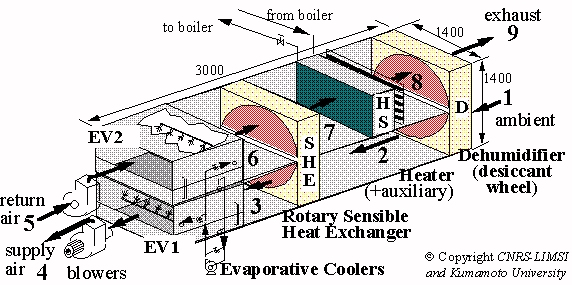Simulation of Desiccant Cooling
Keywords:
desiccant wheel, desiccant cooling, evaporative cooling, sensible heat exchanger wheel, silica gelAbstract
Desiccant cooling system has been an attractive topic for study lately, due to its environmentally friendly nature. It also consume less electricity and capable to be operated without refrigerant. A simulation study was conducted using 1.5 m long ducting equipped with one desiccant wheel, one sensible heat exchanger wheel, one evaporative cooling chamber and two blowers and one electric heater. The simulation study used 8.16 m/s primary air, the drying coefficient from desiccant wheel, k1=2.1 (1/s), mass transfer coefficient in evaporative cooling, k2=1.2 kg vapor/s, heat transfer coefficient in desiccant wheel, h1=4.5 W/m2 oC, and heat transfer coefficient in sensible heat exchanger wheel h2= 4.5 W/m2 oC. The simulation results show that the final temperature before entering into the air conditioning room was 25 oC and RH of 65 %, were in accordance with the Indonesian comfort index.References
L. Bellia, P. Mazzei, F. Minichiello, and D. Palma, “Air conditioning systems with desiccant wheel foritalian climates,” International Journal on Architectural Science, vol. 1, no. 4, pp. 193-213, 2000.
C. Maalouf, E. Wurtz, and F. Allard, “Evaluation of the cooling potential of a dessicant evaporative cooling system using the SimSPARK environment,” UTAP, University of Reims, Campus du Moulin de la Housse, Reims, France, chadi.maalouf@univ-reims.fr.
B. S. Davangere, S. A. Sherief, and D. Y. Goswami, “Feasibility study of solar desicant air-conditioning system–part 1. psychrometric and analysis of the condition-ed zone,” International Journal of Energy Research, vol. 23, no. 1, pp. 7-21, 1999.
K. Daou, R. Z. Wang, and Z. Z. Xia, “Desiccant cooling air conditioning: a review,” Renewable & Sustainable Energy Reviews, vol. 10, no. 2, pp. 55-77, 2016.
M. M. S. Dezfouli, S. Mat, G. Pirasteh, K. S. M. Sahari, K. Sopian, and M. H. Ruslan, “Simulation analysis of the four configure- tions of solar desiccant cooling system using evaporative cooling in tropical weather in Malaysia,” International Journal of Photoenergy, vol. 2014, http://dx.doi.org/10.1155/2014/843617
S. P. Halliday, C. B. Beggs, and P. A. Sleigh, “The use of solar desiccant cooling in the UK: a feasibility study,” Applied Thermal Engineering, vol. 22, no. 12, pp.1327-1338, 2002.
L. Hernandez, J. Heywood, A. Kumar, and Y. Roman, Solar Desiccant Air Conditioner, http://solar.sdsu.edu/Final Docs/Solar Air Conditioning Final Report 490B.pdf, visited April, 2014.
J. J. Jurinak, “Open cycle desiccant cooling component models and system simulations,” Ph. D. thesis, Dept. Mech. Eng., University of Wisconsin-Madison.
S. Jain, P. L. Dhar, “Evaluation of solid-desiccant-based evaporative cooling cycles for typical hot and humid climates,” International Journal of Refrigeration, vol. 18, no. 5, pp. 287–296, 1995.
M. Pons, and A. Kodama, “Second law analysis of the open cycles for solid desiccant air-conditioners,” C.N.R.S.L.I.M.S.I., France and Kumamoto University, Japan, https://perso.limsi.fr/mpons/dsopen.htm, visited April 2014

Published
How to Cite
Issue
Section
License
Submission of a manuscript implies: that the work described has not been published before that it is not under consideration for publication elsewhere; that if and when the manuscript is accepted for publication. Authors can retain copyright in their articles with no restrictions. is accepted for publication. Authors can retain copyright of their article with no restrictions.
Since Jan. 01, 2019, AITI will publish new articles with Creative Commons Attribution Non-Commercial License, under The Creative Commons Attribution Non-Commercial 4.0 International (CC BY-NC 4.0) License.
The Creative Commons Attribution Non-Commercial (CC-BY-NC) License permits use, distribution and reproduction in any medium, provided the original work is properly cited and is not used for commercial purposes.



